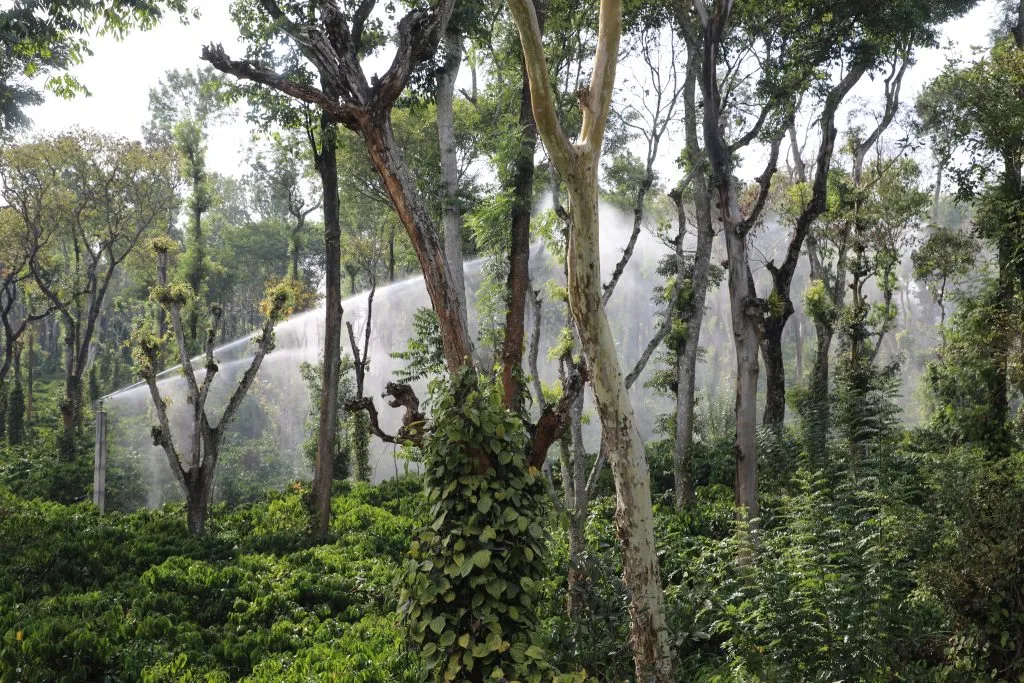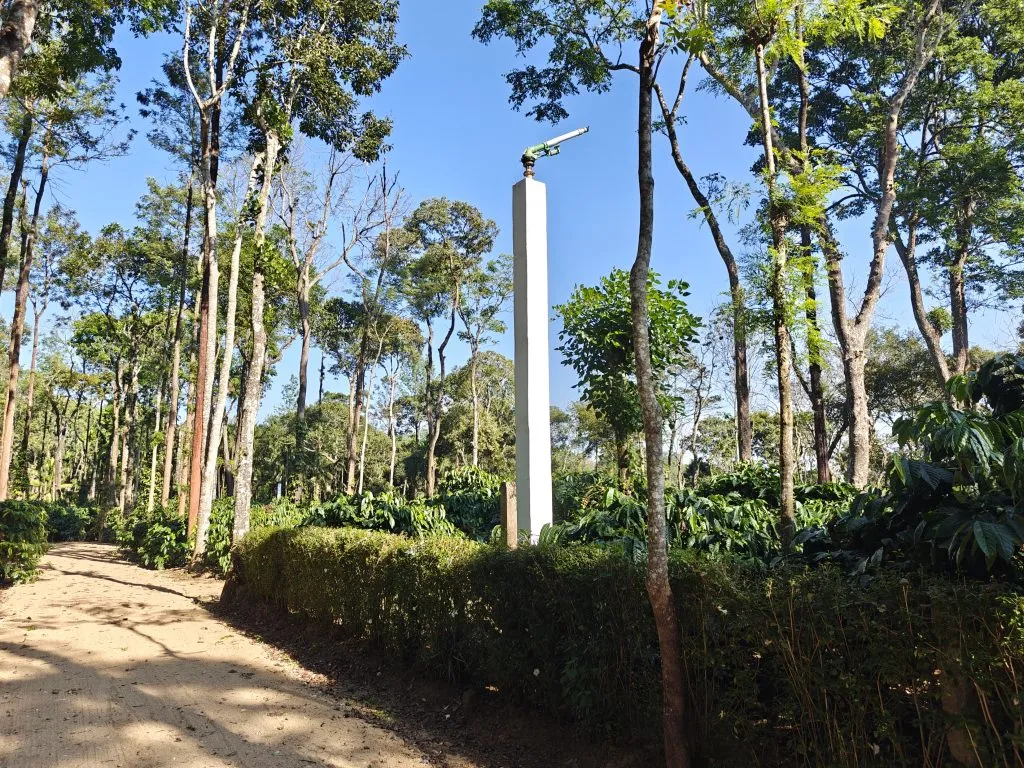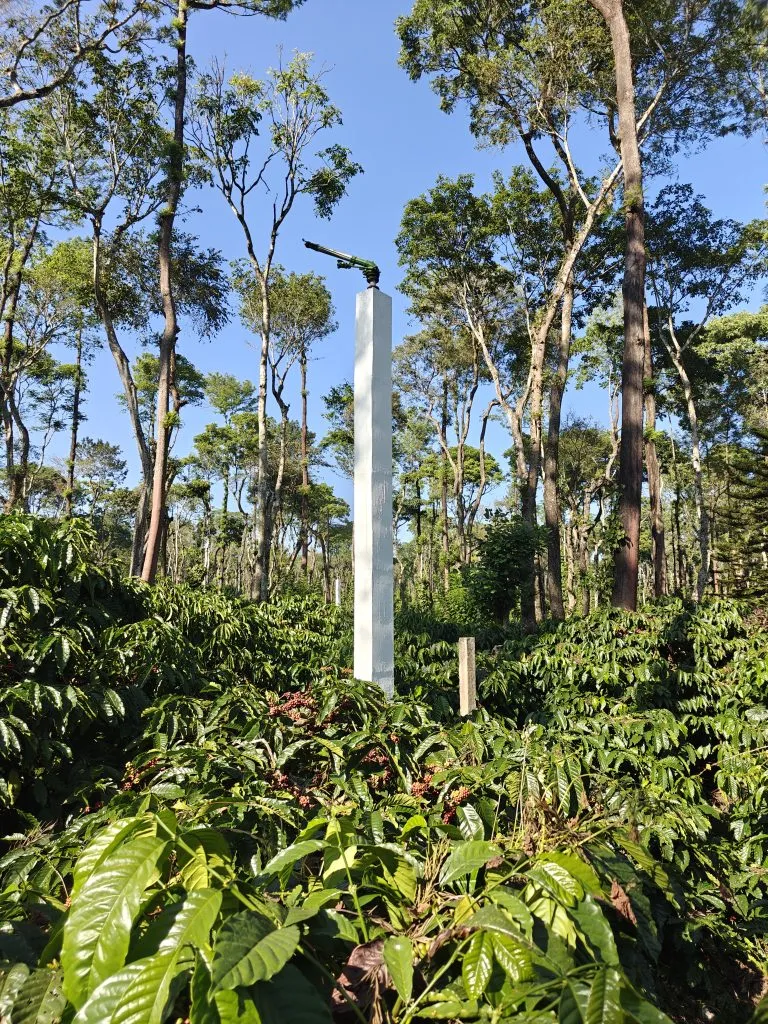by Dr. Anand Titus and Geeta N. Pereira
Joe’s Sustainable Coffee Plantation, located at Kirehalli Estate, Karnataka State, in India, is renowned for its innovative approach to coffee farming, and one of its standout achievements is the pioneering of an energy-efficient and highly mechanized sprinkler system. This advanced irrigation system, which was the first of its kind in India, transformed the way coffee plantations manage irrigation, significantly enhancing efficiency, reducing labor costs, and improving water conservation. In 2011, Joe’s Sustainable Coffee Plantation set a remarkable milestone by sprinkling an area of 116 acres in just three days with a workforce of only 15 workers—a feat that was previously unimaginable in India’s coffee plantation sector.

Achieving a Breakthrough in Irrigation Efficiency
In 2011, we accomplished a remarkable feat: We invited the Chairman of the Coffee Board, Mr. Javid Akthar, alongside 500 coffee Planters from the Districts of Coorg, Hassan and Chikmagalur, for a live demonstration of Rain Gun technology at Joe’s Ecofriendly Coffee Plantation, sprinkling, 100 acres of coffee plantation in just three days, setting a new industry standard for sprinkler irrigation efficiency. This feat was unprecedented, as traditional irrigation methods required much longer periods to cover the same amount of land.
This success not only demonstrated the technological potential of modern irrigation systems but also highlighted the potential for sustainable farming practices that conserve water and increase crop yields. The journey of creating this innovative system, was long and tough, almost 35 years in the making. The challenges faced, were numerous and we had to build the sprinkler ecosystem from scratch because, there were none in the coffee Industry who could understand our concept. The only thing that kept us going was our passion to achieve the impossible.
This breakthrough was achieved through meticulous planning, sophisticated technology, and an innovative design that integrated modern engineering with the principles of sustainable agriculture. By increasing the speed of irrigation, reducing water runoff, and ensuring even distribution of water over a large area in the shortest possible time, the rain gun system proved to be highly efficient in terms of both time and resources.
The Development of the Sprinkler Eco System
The idea of using sprinklers for irrigation in agriculture is not new, but applying the rain gun system specifically to coffee cultivation was an innovative step forward. We were the first in the Country, to introduce Rain guns into coffee. Over the years, we made, substantial investments in both time and resources to develop a cutting-edge irrigation system. The initial goal was simple: to improve the efficiency and speed of irrigation across large tracts of coffee Plantations. However, achieving this goal required overcoming several technological, environmental, and logistical challenges.
The result was the design of a state-of-the-art rain gun sprinkler system that could cover large areas in a short amount of time.

Impact on Coffee Cultivation
The introduction of rain gun sprinkler irrigation at Joe’s Ecofriendly Coffee Plantation had a profound impact on coffee cultivation. Coffee is a water-intensive crop that requires consistent moisture for healthy growth, particularly during critical stages such as flowering and fruit setting. Traditionally, coffee growers in India relied on manual irrigation methods, which were labour-intensive and time-consuming. Moreover, these methods often led to uneven water distribution, with some areas of the plantation receiving too much water while others were left dry. This inconsistency in irrigation resulted in poor crop yields, higher labor costs, and an increased risk of crop failure.
By implementing the rain gun system, we were able to overcome many of these challenges. The rain gun system ensured that water was distributed evenly across the entire plantation, promoting uniform growth of the coffee plants. The rain guns could simulate natural rainfall, which was crucial for maintaining soil moisture and creating an ideal growing environment for the coffee plants. Additionally, the system reduced water wastage, as the rain guns could be calibrated to release only the necessary amount of water, preventing over-irrigation and conserving precious water resources.
The ability to irrigate 100 acres in such a short period also brought significant improvements in terms of operational efficiency. The traditional methods of irrigation often required significant human labor to transport and apply water, which could be slow and costly. By automating the irrigation process with rain guns, we were able to reduce the number of workers needed for irrigation, thereby cutting labor costs and increasing productivity. This had a direct positive impact on the profitability of the coffee plantation.
Moreover, the rain gun system also helped mitigate the risks associated with irregular rainfall patterns in India. Coffee plantations are highly susceptible to droughts and inconsistent rainfall, which can lead to crop failure and significant financial losses. The ability to control the amount and timing of irrigation provided us and other coffee growers with a level of control that was previously unavailable. By using the rain gun system, coffee plantations were able to maintain consistent moisture levels, reduce crop stress, and improve overall yield and quality.
Establishing a New Industry Standard
The success of the rain gun sprinkler system at Joe’s Ecofriendly Coffee Plantation in 2011, motivated us to go to the next level of efficiency. Our end goal was to irrigate 100 acres of coffee in 24 hours. This required out of the box thinking. Since coffee is cultivated in a forest like situation, we had to find a way out to lift the throw of water, either above the tree canopy or above the two-tier shade system. In addition, we had to face the problem of Global warming and Human animal conflict, with wild elephants freely Criss crossing plantations both during the day and night. We had to design a sprinkler system which was both user friendly, economical as well as provided safety to the Rain gun equipment. Our logical thinking, helped us build concrete towers 25 feet to 30 feet high depending on the terrain. In the year 2020 we started building concrete Towers and placed them at strategic points, across the coffee plantation, far apart, so as not to overlap the water from one tower crossing the other. We also tested the efficiency of different models of rain guns, like the Mariner, and Gemini. We also designed our own stainless-steel nozzles of different diameters providing different droplet size, precipitation, throw and comfort to the coffee bush. We experimented the Rain gun Towers sprinkler systems for four years and in the year 2024, the entire process was standardized and we were successful in sprinkling an area of 100 acres in 48 hours.

The system was based on permanent concrete towers ranging from 20 to 30 feet in height. These towers were strategically placed across the plantation to maximize water distribution. The rain guns, which were mounted on top of these towers, were designed to rotate and distribute water over a wide area in a manner similar to natural rainfall. The use of concrete towers ensured the stability and durability of the system, especially in a challenging environment where high winds, heavy rainfall, and varied terrain could affect traditional irrigation infrastructure.
The rain guns operated under varying pressure conditions, which allowed them to distribute water uniformly over large sections of the plantation. This characteristic was essential for coffee cultivation, as coffee plants require consistent moisture levels to thrive. Traditional irrigation methods such as drip irrigation or manual watering could not match the efficiency and scalability of the rain gun system. The system, so developed was designed to irrigate large areas in the shortest possible time, reducing labor costs and increasing productivity. The success of this system was not just in its speed, but also in its uniform distribution of water. The rain guns created a fine mist that replicated natural rainfall, ensuring that every part of the plantation received the same level of hydration, which is critical for the health of the coffee plants.
Inspiring the Present And The Future Generations

This breakthrough sparked interest among other coffee plantations in India, leading many to adopt similar rain gun sprinkler systems. The widespread adoption of this technology revolutionized coffee cultivation, particularly in regions that faced water scarcity. Coffee growers began to realize that the rain gun system not only improved irrigation efficiency but also contributed to environmental sustainability by conserving water and reducing reliance on manual labor.
The impact of our innovative state of the art sprinkler system, went beyond the coffee industry. The rain gun sprinkler system developed at Joe’s Ecofriendly Coffee Plantation became a model for other crops as well. The system’s ability to cover large areas quickly, distribute water uniformly, and conserve water resources made it an ideal solution for a wide range of agricultural applications.
The Role of Sustainability in Agricultural Practices
One of the most significant aspects of our work, which is often overlooked by the coffee Planters is our emphasis on sustainability. As a proponent of eco-friendly practices, we are deeply concerned about the environmental impact of traditional farming methods, particularly with regard to water use. The rain gun system was designed not only to improve productivity but also to minimize water wastage and environmental degradation.
In regions where water resources are limited, the efficient use of water is crucial for ensuring the sustainability of farming practices. By adopting the rain gun system, coffee growers were able to reduce their water consumption while maintaining healthy crop yields. This shift towards more sustainable irrigation practices helped mitigate the environmental impact of coffee cultivation, making it a more viable and eco-friendly industry in the long run.
Conclusion
Our pioneering efforts in the development and implementation of rain gun sprinkler irrigation at Joe’s Ecofriendly Coffee Plantation have had a profound impact on coffee cultivation, both in India and internationally. It revolutionized coffee cultivation and demonstrated the potential for modern irrigation solutions to enhance agricultural productivity and sustainability. Our work serves as an example of how determination, creativity, and technological advancements can transform traditional agricultural practices and pave the way for a more sustainable future in farming.
References
Anand T Pereira and Geeta N Pereira. 2009. Shade Grown Ecofriendly Indian Coffee. Volume-1.
Bopanna, P.T. 2011.The Romance of Indian Coffee. Prism Books ltd.
State of the Art Energy Efficient Sprinkler Systems
Rainguns – The Future of Sprinkler Irrigation